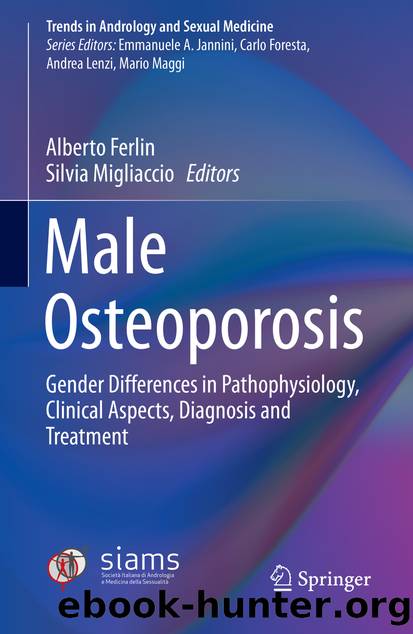Male Osteoporosis by Unknown

Author:Unknown
Language: eng
Format: epub
ISBN: 9783319963761
Publisher: Springer International Publishing
10.2 Alcohol Abuse
Alcoholism is a disease characterized by a dependency on alcohol. Since alcohol affects almost every organ in the body, chronic heavy drinking is associated with many serious health problems, including pancreatitis, liver disease, heart disease, cancer, and osteoporosis. Alcohol negatively influences bone health for several reasons. Past findings agree with in vitro studies that demonstrate diminished osteoblast numbers and osteoblast function in humans, suggesting a direct effect of alcohol on osteoblast by mean of a reduction of biosynthesis of osteocalcin [28]. Microscopic studies of bone tissue from rats demonstrated decreased trabecular bone volume, decreased numbers of osteoblasts, and decreased rate of bone formation. These experimental evidence suggests impaired bone formation and mineralization, along with other characteristics indicative of osteoporosis [29]. These effects on the bone may be exerted indirectly through the many cell types such as hormones and growth factors that regulate bone metabolism. Men with alcoholism have a reduction of biosynthesis of several hormones such as testosterone and IGF-1 and cortisol; these hormonal changes have a negative impact on osteoblastogenesis [30]. Excessive alcohol interferes with the balance of calcium. Calcium balance is further disrupted by the alcohol’s ability to interfere with the production of vitamin D essential for calcium absorption [31], with a secondary normal-elevated levels of parathyroid hormone (PTH) [32].
Clinical studies investigating alcohol intake and bone health suggest a “J”-shaped curve, where moderate ingestion of alcohol may offer maximum protection; however, intakes beyond this level show negative effects on the skeleton [33]. Chronic heavy alcohol consumption is associated with decreased BMD [34–36] and increased fracture risk [37–39], but there have been notable discrepancies. In contrast moderate drinkers (for men ≥3 day per week with a consumption ≤28 g/day ethanol) appear to have neutral or beneficial effects. Differences may be related to dose, pattern, and duration of drinking and skeletal site(s) evaluated. For example, Pumarino and colleagues evaluated the skeleton in male continuous and intermittent heavy drinkers [40]. Osteopenia was noted in the femur neck but not in the spine, suggesting site specificity, and the type of alcohol abuse was found to be less important than duration. However, a recent study evaluated the relationship between current alcohol consumption and the bone in the distal radius and tibia in aged men and women using high resolution computed tomography [41]. In contrast to the above analyzed studies, moderate to heavy alcohol consumption was associated with minimal changes in bone geometry, density, and microarchitecture. Inexplicably, light drinking was associated with generally negative effects on indices of bone quality in males but not females. It should be noted, alcoholics differed among studies in age and duration of alcohol abuse and ranged from healthy to having cirrhosis, pancreatitis, diabetes, and other conditions that may influence bone metabolism.
Download
This site does not store any files on its server. We only index and link to content provided by other sites. Please contact the content providers to delete copyright contents if any and email us, we'll remove relevant links or contents immediately.
The DNA Book by DK(777)
The Spike by Mark Humphries;(769)
The End of Food Allergy by Kari Nadeau MD PhD & Sloan Barnett(687)
Extra Life by Steven Johnson(666)
Your Brain Is Always Listening by Dr. Daniel G. Amen(653)
How to Sleep by Rafael Pelayo(601)
Unlocking Eden: Revolutionize Your Health, Maximize Your Immunity, Restore Your Vitality by Belt Daniel & Horn Joe(594)
The Hashimoto's AIP Cookbook: Easy Recipes for Thyroid Healing on the Paleo Autoimmune Protocol by Emily Kyle MS RDN CLT HCP & Phil Kyle Chef(592)
The Hospital by Brian Alexander(590)
The Low-FODMAP IBS Solution Plan and Cookbook by Rachel Pauls(583)
The Covid Survival Guide: What the Virus Is, How to Avoid It, How to Survive It by Rowell David(566)
The Big Book of Baby Names by Marissa Charles(553)
Lymph & Longevity by Gerald Lemole(539)
Linda Goodman's Love Signs by Linda Goodman(521)
Better Living Through Neurochemistry - A guide to the optimization of serotonin, dopamine and the neurotransmitters that color your world by James Lee(515)
Thrivers by Michele Borba Ed. D(508)
The Miracle Pill by Peter Walker(503)
Stroke For Dummies by John R. Marler(491)
Immunity by Jenna Macciochi(487)
